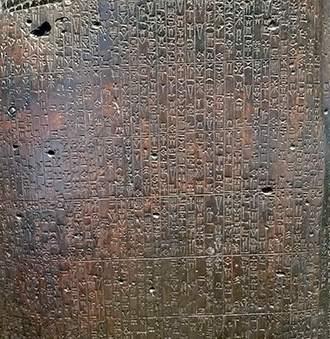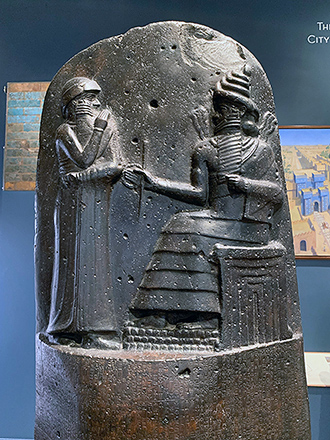在西元前3100年至西元前3300年之間,沿著底格里斯河、幼發拉底河和尼羅河河畔興起的早期農業文明,發展出政府體制、類都市的大規模城鎮和人力的專業分工(complex divisions of labor)與官僚等級(bureaucratic hierarchies)。到了西元前3100年,在埃及境內,所有沿著尼羅河流域,上至北部尼羅河較下游的三角洲,下至南部遠達尼羅河上游的區域,皆在法老體制(Pharaonic system)之下統一。幾世紀之後,約西元前2334年左右,阿卡德王朝在美索不達米亞城邦的統治者-薩爾貢(Sargon),擴大了他的政治影響力,遍及美索不達米亞大部分的地區。而具有城市化和可能制定法律能力的其他當代文明,則有卡拉爾文明(Caral Civilization )或稱北奇科文化(位於現今秘魯中部海岸)和南亞沿印度河流域所興起的文明。
Between 3300 and 3100 BC the early agricultural civilizations along the Tigris and Euphrates, and also along the Nile, developed governments, large towns that could be considered cities, and complex divisions of labor and bureaucratic hierarchies. By 3100 BC Egypt all along the Nile, from the lower delta area in the north to the upper areas far to the south had been unified under a Pharaonic system. Centuries later, around 2334 BC, Sargon, the ruler of the Mesopotamian city state of Akkad expanded his political influence through most of Mesopotamia. The only other contemporary civilizations that were urbanized and probably had codes of law at this time would be the Caral Civilization (or Norte Chico Culture) of what is now the central Peruvian coast and the civilization rising along the Indus River in south Asia.
雖然看起來在埃及和美索不達米亞兩地,很可能有定期制定、編寫和發佈法規的文明,不過在眾多法典中,較引起歷史學家們注意的一部法典是制定於西元前1792年的漢摩拉比法典(the code of Hammurabi),這是一部以書面形式,最早也至今保存較為完整的法典之一,出現的時間是在薩爾貢國王建國500年之後,也是在法老統治下,埃及統一大約1300年之後。
While it seems likely that both the Egyptian and Mesopotamian civilizations regularly established legal codes and had them written and distributed, historians give much attention to one of the earliest codes of law to survive down to the present in written form, the code of Hammurabi, which dates to 1792 BC, a little over 500 years after Sargon established his empire, and approximately 1,300 years after the unification of Egypt under a Pharaoh.
漢摩拉比的法律並不是最早出現的,在烏魯伊寧基那法規(the rule of Uruinimgina)中倖存下來的法令,甚至可以追溯到西元前2374年左右,是由烏魯伊寧基那(Uruinimgina)國王在拉格什(Lagash)城邦執政時所制定的,而西元前2100年或西元前2040年左右(年代不確定),烏爾-納姆國王統治的烏爾、埃里都、烏魯克和尼普爾等城邦,當時所撰寫的烏納姆法典(Ur-Nammu’s legal codes),也有近一半的法條被保存下來。所以烏魯伊寧基那法典比漢摩拉比法典早了550多年,而烏納姆法典也比漢摩拉比法典早了250-300年。
Hammurabi’s laws were not the first. Some rules and laws dating to the rule of Uruinimgina in Lagash around 2374 BC have survived, as have about half of the law codes of Ur-Nammu who ruled over Ur, Eridu, Uruk, and Nippur. Ur-Nammu’s legal codes date to around 2100 BC or 2040 BC (chronologies are not certain). So Uruinimgina’s laws predate Hammurabi’s codes by over 550 years, and Ur Nammu’s codes are 250-300 years earlier than Hammurabi’s.
美索不達米亞有幾個不同的民族(ethnic groups),其中有五個比較重要的族群是:
· 蘇美爾人Sumerians(說蘇美爾語,一種與任何其他語言沒有鏈接的語言)
· 阿卡德人Akkadians (說東閃族語eastern Semitic language)
· 亞摩利人Amorites(來自西北高原,說西閃族語western Semitic language)
· 埃蘭人Elamites(從高原地區到美索不達米亞的東部,此民族住在蘇薩城,當地居民實行男女平等,其語言與其他語言不存在任何親屬關係)
· 古提人Gutians (也是來自底格里斯河和幼發拉底河沿岸西北城邦的地區,也是說一種孤立語言language isolate)
Mesopotamia had several different ethnic groups. Five of the significant ones were:
1) Sumerians (who spoke Sumerian, a language without known links to any other language),
2) Akkadians (who spoke an eastern Semitic language),
3) Amorites (from northwestern highlands, and speaking a western Semitic language),
4) Elamites (from highlands to the east of Mesopotamia, who had the city of Susa, who practiced equality of men and women, and spoke a language with no known relationships to other languages), and
5) Gutians, also from areas to the north and west of the city states along the Tigris and Euphrates, and also speaking a language isolate.
漢摩拉比國王是亞摩利人,在世期間是西元前2000至西元前1600年,也是亞摩利人在美索不達米亞最具有影響力和統治地位的時期。漢摩拉比國王的軍隊擊敗並摧毀馬里、烏爾等國,烏爾的滅亡結束了城邦各自獨立的蘇美爾文明,併入在漢摩拉比國王統治下,由亞摩利人建立的巴比倫王朝。在巴比倫定居下來的亞摩利人,譬如說漢摩拉比國王,就延用了許多蘇美爾文明中的宗教與文化觀點,因此,雖然薩爾貢國王的阿卡德帝國統一了各自為政的蘇美爾城邦和延續到後來漢摩拉比國王的巴比倫第一帝國(古巴比倫帝國),並沒有真正的終結蘇美爾文化。
King Hammurabi was an Amorite, and he lived during the period from 2000-1600 B.C. when the Amorites were most influential and dominant in Mesopotamia. King Hammurabi had his armies defeated and destroyed the nations of Mari and Ur, and the destruction of Ur ended independent Sumerian Civilization, which merged with the Amorite kingdom of Babylon ruled by Hammurabi. The settled Amorites such as Hammurabi who lived in Babylon had adopted many of the religious and cultural aspects of Sumerian civilization, so the end of independent Sumerian city states as they were unified in the Akkadian empire of Sargon, and then later the First Babylonian Empire under Hammurabi, was not really an end of Sumerian culture.
漢摩拉比國王算是巴比倫第一王朝(the First Babylonian Empire)中執政最成功的國王,在位時間從西元前1792年到西元前1750年。之後,巴比倫第二王朝(新巴比倫帝國)崛起並歷時1100年之久。而聖經中所出現的著名人物亞伯拉罕,時間是發生在巴比倫第二王朝的時代,據說他的家鄉在烏爾,不過此烏爾應該是在現今土耳其東南部的尚勒烏爾法(Sanliurfa)或稱烏爾法(Urfa),跟巴比倫時期的烏爾城是兩個截然不同的地點。
King Hammurabi was the most successful king of the First Babylonian Empire, ruling from 1792 to 1750 BC. There was a second Babylonian Empire that rose to dominance about 1100 years after the days of King Hammurabi and the first Babylonian Empire. It is that second Babylonian empire that figures prominently in the Bible. Also, the best evidence suggests that the Ur mentioned as the home town of Abraham in the Bible was located in what is now Southeast Turkey, and is now called “Sanliurfa” or “Urfa”, and was not the city state of Ur in Mesopotamia.
漢摩拉比國王花了許多年才在軍事上取得成功,他直到西元前1762年才完全的征服了鄰國,在此之前,巴比倫第一王朝給人的印象並不深刻。在漢摩拉比之前,巴比倫有過五任國王,在漢摩拉比之後,他的繼任者只持續了155年的執政,帝國便走向衰敗並喪失國土,直到西元前1595年,巴比倫被赫梯人(Hittites)的國王穆爾西里一世(Mursilis I)洗劫一空,最後由赫梯人的盟邦喀西特人(Kassites)接管巴比倫。
The First Babylonian Empire wasn’t an impressive empire until Hammurabi had his military successes, which took him many years to accomplish; as he did not complete his conquest of neighboring states until about 1762 BC. Before Hammurabi, there were five previous kings in Babylon, and after Hammurabi, his successors presided over 155 years of decline and loss of territory until finally in 1595 BC, Babylon was sacked by the Hittites ruled by Mursilis I, and the Hittites handed over Babylon to their allies the Kassites.
漢摩拉比國王在征服美索不達米亞大部分的地區後,宣布了他的法典,裡面共有282條法律條文,全文是以楔形文字刻在一塊高2.25米的黑色玄武岩上,此石碑現藏於法國巴黎的羅浮宮博物館(the Louvre museum)。在西元前1160年左右,蘇薩(Susa)的埃蘭人擊敗了喀西特人,並將刻有漢摩拉比法典的石碑當為戰利品帶回了蘇薩。雖然這塊目前典藏在羅浮宮的著名石碑,有些法律條文被去除掉了(可能是埃蘭人所為),不過有很多其他的複製品被找到,在幾百年的改朝換代中,法典裡面的條文似乎沒有很大的變更,法典是以阿卡德語所篆刻出來的,是薩爾貢國王的阿卡德帝國(西元前2334年-西元前2154年)所使用的語言。
After conquering most of Mesopotamia, Hammurabi proclaimed his legal code. There are a total of 282 legal articles in the code. The full text of the code was carved in cuneiform on a black basalt stone 2.25 meters high, which is now in the Louvre museum in Paris. Elamites from Susa brought the stele with Hammurabi’s laws as war treasure when they defeated the Kassites around 1160 BC. Although some of the laws were erased from the famous stele in the Louvre (probably by the Elamites), many other copies of Hammurabi’s legal code have been found, and the laws seem to have endured in successive empires for hundreds of years with little change. The legal code was engraved in Akkadian, which was the language of Sargon and the Akkadian Empire (2334 to 2154 BC).

漢摩拉比法典是以楔形文字刻在石碑上
而在漢摩拉比之後的古巴比倫帝國,可以在楔形文字的泥板上,找到很多法庭上的判決和案例,顯然的法院並沒有在實際的判決中運用漢摩拉比法典裡的法條,法典存在的目的,或許只是用來告示對被定罪之人的罰責之一般原則。漢摩拉比法典有前言(prologue)和結語(epilogue),主要在強調法律是保護弱者免於強者的欺凌,法典裡也特別規定了三個等級的社會階級:紳士或貴族、平民和最底層的奴隸。如果是貴族殺了貴族,懲罰是死刑,如果是貴族殺了奴隸,貴族可以付一筆贖罪金(blood money/price)來補償奴隸的主人。
There are many court cases and judgements that can be found on cuneiform clay tablets from the First Babylonian Empire after Hammurabi, and from these it appears that the laws of Hammurabi were not applied in actual court decisions. They probably served a purpose of showing general principles of assigning punishments to persons whose guilt was established. The laws of Hammurabi have a prologue and epilogue, which emphasize that the purpose of the laws is to protect the weak from the aggression of the strong. The codes also specify three class levels in society: a gentry or aristocracy, a level of commoner, and an underclass of slaves. If a noble person kills another noble, the penalty is death, but if a noble kills a slave, the noble may offer a blood price to compensate the owner.
漢摩拉比法典在美索不達米亞雖歷經了幾個世紀,不過少有修改,如同許多法律的制定,合法的為社會中的特權分子和剝削者提供了保留特權,但同時也試圖為平民和奴隸階級者在某種程度上提供了正義和保護,免於不平等的待遇或剝削。因此,政府間處在緊張局勢的典型例子,便是一邊試圖創造社會的穩定並保護權勢者的利益,同時也限制士紳的權力,為窮人和被奴役者提供一些保護。尤如許多的法典,包括聖經中的那些法規,漢摩拉比法典的由來也宣稱是受到神源的啟發,而非純粹是人為的想像和發明的產物,在羅浮宮裡面這座著名的石碑可看出一個端睨,由最上層的浮雕所呈現的是坐在寶座之上的太陽兼正義之的神沙馬什(Shamash)正在授與漢摩拉比國王象徵人世間權力的權杖。
Hammurabi’s code endured with few modifications for many centuries in Mesopotamia. Like many laws, it offers legitimacy and a conservative preservation of privilege and exploitation in society, but at the same time it attempts to offer commoners and slaves some degree of justice and protection from unfair treatment or exploitation. Thus, it exemplifies the tension in governments, of trying to create stability and protect the interests of those with power and wealth, while at the same time putting constraints on the powers of the gentry and providing for some protections for those who are poor or enslaved. Like many legal codes, including those in the Bible, the laws of Hammurabi claim to be inspired by Divine sources, and not merely the artifacts of human imagination and invention. The famous stele in the Louvre shows at the top an image of Hammurabi receiving the laws from the sun and justice god Shamash, sitting on a throne and handing to Hammurabi a scepter of earthly power.

圖片上所看到的漢摩拉比法典石碑為複製品,展示於芝加哥大學東方研究所博物館。
|
|
相關連結


